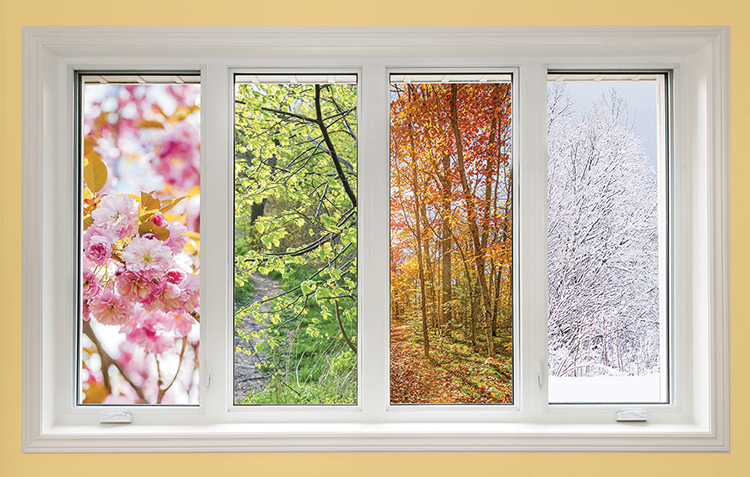After the past few summers of record-breaking temperatures, many Maine people who had a point of pride in not owning an air conditioner have broken down and bought window units. Staying cool is more important than looking cool, right?
To offset growing electricity bills, you’ll want to invest in long-term energy efficiency, and new tax credits could help you fund a few different projects, including replacements for the very windows in which your units sit.
MAKING A BUDGET
Over the next ten years, U.S. homeowners will be able to claim a tax credit for 30 percent of the cost of qualified projects that make their home more energy efficient. Claims can be made each qualifying year, with an annual cap of $1,200 and a lifetime cap of $14,000 in credits.
According to analysis from personal finance publication Kiplinger’s, these are some of the best uses of those tax credits:
• $150 for home energy audits
• $600 for exterior windows and skylights
• $250 for one or $500 total for all exterior doors
• $2,000 for electric or natural gas heat pumps, electric or natural gas heat pump water heaters, and biomass stoves and boilers. For this category, the $1,200 annual cap will be waived.
Combine these credits with the state-level rebate programs offered at Efficiency Maine and you could be receiving five figures in rebates and tax credits to upgrade your home’s exterior, insulation, heating sources, or appliances.
CHOOSING WINDOWS

The Maine Window Company owners and employees pose for a photo on a work day. Left to right, front: Chris Cummings, Henry Cummings, Calvin Cummings, Kate McGrath, and Lisa Corey. Rear: Buddy Minot and Rachel Cummings. The Maine Window Company
According to the Department of Energy, windows account for 25 to 30 percent of a home’s cooling and heating use, which is pretty close to what Energy Star certified windows will save you on those bills (20 to 30 percent).
Now, here’s your vocabulary word of the day: fenestration, the architectural term for how windows, doors and skylights are arranged on a building. The National Fenestration Rating Council, an independent nonprofit, certifies Energy Star products, the kind you need to be installing or buying to qualify for these savings.
A standard double-paned, argon-filled window with a low-e coating will keep energy from leaving your home, but to reduce heat intake, you will want a window that is also rated with a low U-factor and a low solar heat gain coefficient (SHGC).
CHOOSING DOORS
“I love my windows, but I’m in love with my storm door,” says Kate McGrath of The Maine Window Company. McGrath recommends front and back storm doors as both an easy way to air out the house in the evenings when the weather warms up and as a layer of cold air protection when winter rolls back around.
McGrath has a self-storing storm door made by Larson and installed by her coworkers. It switches between insulated glass panel and screen, with the spare sliding back into door’s structure. “I had a triple sash old one, so self-storing doors are like magic to me,” McGrath adds.
REPAIR BEFORE REPLACING
The most cost-effective window treatment might be a DIY repair before a replacement. If you have drafts around windows that are in otherwise good shape you can caulk and/or weatherstrip, hang heavy duty curtains or other window coverings, or insert storm windows or interior panels. Solar control film and exterior shading, like awnings can help control heat in the summer.
IT’S ALSO ABOUT LOOKS
Realtor.com says window replacements are one of the most cost-effective improvements you can make to your home because they provide energy savings while transforming your home’s exterior. New colors, sleeker frames, improved sound dampening, and lower energy bills will give you everyday satisfaction and all add up to greater values in curb appeal and quality when it is time to sell.
ASK THE EXPERTS: THE MAINE WINDOW COMPANY

Lisa Corey, co-owner, and Kate McGrath, sales representative
1. Repair or update before you replace. “Replacement windows are a long-term, solid investment, but it can be a lot of money up front. So, we recommend that you first make sure your window can’t be repaired or updated in some smaller way.”
2. Do what you can handle. “We understand people have limited budgets, so we will do even just one window for a client.”
3. Understand the timeline. “We install year-round, but we currently have a 12-week average wait time for installation day. But for most jobs it really is just a day of work! So, you don’t have to worry about this big, disrupting event, plus we take pride in leaving things cleaner than we found them.”
4. Know who’s doing the work. “We are a company of just five employees. Our customers benefit from the personal attention we give. With us, the person who will be on site doing your replacement is Chris, who is a co-owner, and/or Buddy Minot. They both have spent around twenty years doing this work.”
5. Customer service has value. “Basically, we give people the experience we would want our parents to have in this transaction. We want people to be happy with the product and installation. Sometimes we do the whole house, but a lot of people do it piecemeal, so we get to really know people over the years.”

Comments are not available on this story.
Send questions/comments to the editors.


